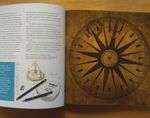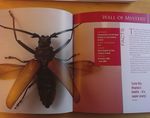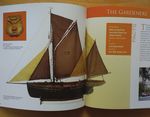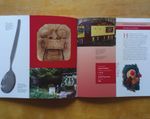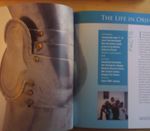Glasgow Open Museum; taking the Collection into the Community
←
→
Page content transcription
If your browser does not render page correctly, please read the page content below
Glasgow Open Museum; taking the
Collection into the Community
We Curate: Research on best practices for inclusive curating
Often, museums give you a feeling of authority; objects are put on display in
showcases and the texts on the wall explain the story of famous artists from
an omniscient narrator point of view. You enter the exhibition, absorb all the
content that is provided by the museum, and leave again. The museum experience
you’ll have from this exhibition will be informative but very abstract. Another
way of creating a museum experience is giving the audience the opportunity to
determine the content of the exhibition and tell the stories about the objects
themselves.
However, as Nina Simon (author of the book ‘Participatory Museum’) writes in
her blog Museum 2.0; ‘One of the primary fears museum professionals (and all
professionals) have about entering into new relationships with audiences is the
fear of losing control’.1 What remains the function of museum professionals Open Museum logo
when the audience has taken their ‘authority’ from them? This is where the Open Images from www.glasgowlife.org.uk
Museum Glasgow (OM) comes in; ‘The OM team is made up of curators, outreach
assistants, a technical team and a manager. They call themselves facilitators,
creative practitioners and designers, experimenting with a range of participatory,
inclusive ways of working to engage people with objects, designing and building
community-led exhibitions to the highest professional standard. The museum team
brings a wide range of professional experience to help community relationships
create exhibitions in their own institutions outside the museum venues.2
The Open Museum provides a loan service for people to borrow museum objects
to support their own community-based work. In this way the Open Museum is
able to reach many more people with their collection than would otherwise be
possible. Through the ‘loan-service’, the museum encourages organizations and
Exterior of the Glasgow Museums Resource
individuals to use the collections themselves. ‘A final presentation of the work is Centre, which houses the Open Museum
also key – giving people the opportunity to stand back and reflect on what they image from harriethill21.wordpress.com
have achieved and to share it with family and friends. Giving the opportunity
to individuals and organization to create an exhibition in their institution opens
the door to different cultural venues across the city; the Open Museum tries to
democratize the sense of ownership of the collection and other museums and
other cultural spaces. The exhibitions are designed and built by the technical
team of the museum and they carefully balance group choices with responsible
care of the collections. Whatever the scale, the important thing is that the people
feel ownership of the exhibition’.3 The museum really feels a responsibility to
influence the power bases in museums to bring about institutional change – to
ensure that the core museum is affected by the opportunity for dialogue with its
communities.
1 N. Simon, “The Future of Authority”, Museum 2.0 (blog), (October 08, 2008), http://
museumtwo.blogspot.nl/2009/01/starting-exercise-for-designing.html, consulted on 06-02-2014
2012.http://museumtwo.blogspot.nl/2008/10/future-of-authority-platform-power.html
2 E. Addington et al., Out There. The Open Museum: Pushing the boundaries of museums’
potential. (Glasgow: Glasgow Museums, 2010), XI. Consulted on 06-02-2013
3 E. Addington et al., Out There. The Open Museum: Pushing the boundaries of museums’
potential. (Glasgow: Glasgow Museums, 2010), XI. Consulted on 06-02-2013
www.wecurate.euGlasgow Open Museum; taking the Collection into the Community We Curate: Research on best practices for inclusive curating In 2010, the Open Museum published the book Out There. Out There is a celebration of the twentieth anniversary of the Open Museum. The book is written by the Open Museum team and presents all sorts of different projects initiated by the museum. The book is divided in 5 chapters with different themes; each chapter contains about 5 stories about projects, all with different participating ‘co curators’. On the first page of the chapter you find facts about the project; which and how many participants were included in the project, what was the location of the project and what was the duration of the project. The latest chapter explains the ‘behind the Open Museum perspectives’. The intention of the OM is to bring curators nearer to their public. Julian Spalding, The Open Museum publication; Out There former head of Glasgow Museums (1989/1998), says the following; “My ambition Photo: Julia Geven was to have every curator throughout Glasgow Museums (and other members of staff, including Museum Assistants) working on at least one Open Museum project all the time”.1 At this moment the Open Museum holds 23 handling kits and 35 reminiscence kits that could be used by other organisations and individuals. You can find more information about these kits on the Glasgow Open Museum Website. The questions I asked about the museum and its projects were answered by Claire Coia and Crawford McGugan, curators at the Open Museum; What has been your working strategy? The Open Museum publication; Out There The Open Museum works to Glasgow Museum and Glasgow Life Strategic Photo: Julia Geven Objectives and the National Outcomes. We take the museum collection beyond the museum walls out into the community. This involves: Identifying needs within the community; identifying and forming partnerships with key organisations with areas of expertise in addressing these needs; creating standards for best practice; using our extensive museum collection to engage with our communities in a directly relevant way. What inspired you to start this project? What kind of projects or disciplines inspired you? All the Open Museum projects are outreach based. I look for inspiration from the groups that we work with, the skills that they bring and their areas of interest, then work from there. It’s a growing process. With the partners I work out what the key aims of the project are – a combination of their aims and ours – and work The Open Museum publication; Out There with the participants to realize those aims. Photo: Julia Geven My particular focus lies with museums and the Criminal Justice System (each Learning and Access and Outreach Curator has responsibility for a ‘Portfolio’). The key overarching aim for working in this field is rehabilitation. The two other Curators in the Open Museum have portfolios on Regeneration and Health. Each portfolio is based on addressing a need that has been identified. 1 E. Addington et al., Out There. The Open Museum: Pushing the boundaries of museums’ potential. (Glasgow: Glasgow Museums, 2010), 121. Consulted on 06-02-2013 www.wecurate.eu
Glasgow Open Museum; taking the
Collection into the Community
We Curate: Research on best practices for inclusive curating
How was or is the relation between the curator (or concept designer) and the
public/ participators in the process of “exhibition” making? Did the public have
any influence on the process and in what way?
As the Open Museum, we have our key aim of increasing access to the collections
through outreach – and we work to Glasgow Museums, Glasgow Life and National
Strategic Objectives. We match those aims up with the partner’s aims (a literacy
focus or working towards improving mental health, for example). We then meet
with the group and consult with them as to their areas of interest, what their
ideas are, and look at ways of realizing those ideas. As museum professionals with
certain procedures to follow (staff time, resources, conservation requirements,
display requirements, safety of collections etc), we are able to take those ideas The Open Museum publication; Out There
and say what is realistic or possible. We take the parameters, the ideas, and work Photo: Julia Geven
together to find the best solution possible. This also applies to interpretation
– there may be limitations (such as no offensive language, no misleading
information etc.) but inside these limitations we are wide open to what the group
wants, and they have key influence on the direction of the project – we take their
lead. We work with partner organisations to identify community needs and this is
our starting point. Partnerships are key to identifying community need and how
we can effectively work with people in our communities to address those needs.
We are part of a bigger process.
How did or do you realize participation? How do you manage to tell one story
while receiving a lot of different input in “storytelling” by the public?
Everyone has a story to tell. I facilitate group work and encourage the group to
decide for themselves – it’s their project after all. Interpretation / art work. etc The Open Museum publication; Out There
that doesn’t get directly used in the final outcome can be shown and celebrated Photo: Julia Geven
at the project launch and on the website. The final output has to be decided
by the participants: the group facilitation is managed so that everyone can have
equal and fair input and ultimately have responsibility for the project.
How do you prevent a participation paradox (the public isn’t satisfied with the
outcome of their input in “exhibition making” process)?
There will always be parameters to work within since we are working with
museum collections. We try to accommodate where we can and explain why
certain things can’t be done (e.g. display of a fragile object that they have
chosen; an opinion which is offensive; the word count for an exhibition label
and so on). Parameters are emphasized at the beginning of the project - and
throughout - so that everyone knows what they are working towards and has a
The Open Museum publication; Out There
clear outcome in mind. With the group taking ultimate responsibility for the Photo: Julia Geven
direction of the project, the outcome is in their hands. Sometimes last minute
changes may need to be made during the production of the output (e.g. a change
to the display to accommodate an unexpected difficulty in displaying an object)
and any changes are explained to the participants. Good communication is key.
www.wecurate.euGlasgow Open Museum; taking the Collection into the Community We Curate: Research on best practices for inclusive curating How do you realize online and offline platforms for your project? Online activity in terms of project work is focussed around the Open Museum website and Open Museum Facebook page. Beyond that online platforms would have to be considered on a case by case basis. As our ethos is using museum objects to engage with people in non museum spaces we haven't explored online potential in any great extent. Recent online specific projects have included the Outreach Network and Red Road Flats sites. The first is an attempt to provide and develop a support network for those working in museums or galleries in Scotland. Initial funding was provided by Museums & Galleries Scotland in 2009 and developmental work was carried out by The Open Museum publication; Out There a committee from around the country. Photo: Julia Geven Red road Flats website was developed as part of a larger Red Road Engagement Project involving partners beyond museums. It was a great success and had an ability to generate reminiscence content from around the world. In terms of offline platforms we have developed an outreach project into a short film that now features in permanent display at the Riverside Museum - Journeys to Glasgow. Other offline digital projects have included short films. What sorts of resources do you have available and visible for the possibility of participation in your project? The participants that I work with are from excluded, hard to reach and often The Open Museum publication; Out There vulnerable groups in our community. I work with key partners who identify groups Photo: Julia Geven / participants to work with based on their professional knowledge and experience. What would be your ideal situation of curating/ project developing in the future? An ideal situation would be where museums are considered as dynamic forums for reflection, discussion and inhabiting. Museums as spaces that represent not simply past concerns but present and future ones too. But thinking pragmatically for a moment I would say that, in an ideal situation, colleagues having the opportunity to get out of the museum (bunker) to see how objects can be used in dynamic ways around the city with different communities. What is your ideal ‘third place’ (informal meeting place)/ critical community? The Open Museum publication; Out There The ideal informal meeting place would be a multifunctional space where Photo: Julia Geven social and economic functions merge and compliment each other. A space that is intergral to a community and place. Perhaps a piazza - outside. Perhaps an art centre with office and shopping - inside. But mostly my type of work means meeting where people are most comfortable themselves - might be at home, in café. So, to me, that's the best ideal. I don't think about critical communities. I think about 'who gets it'. That's the people to work with and learn from. www.wecurate.eu
Glasgow Open Museum; taking the
Collection into the Community
We Curate: Research on best practices for inclusive curating
The Glasgow Open Museum is part of Glasgow Museums, an overarching
organization with the largest civic museum service in the UK. The Glasgow
Museum contains ten museums and galleries, including the Gallery of Modern Art
(GoMA) and St Mungo Museum of Religious Life and Art, one of only four museums
of religion in the world. The concept of the Open Museum was created as a part of
Glasgow museum. The OM is a place were museum professionals learn from people
who normally don’t visit museums. The Open Museum is based in the Glasgow
Museums Resource Centre, which houses 80% of the collections not on display and
gives access to 1.4 million objects. The objects differ from world-class collections
of fine art to natural history and world cultures.
At the heart of Glasgow Museums is a fundamental philosophical commitment The Open Museum publication; Out There
to the museum as a civic space, one that facilitates discussion around current Photo: Julia Geven
and historical issues, beliefs and cultures; a ‘safe ‘ space for perceptions,
ideas, stories and issues to be presented; where awareness is raised and a clear
invitation given out to visitors and participants to contribute and shape the
discussion being stimulated by what is on display. The Open Museum enlarges this
statement of the museum as a civic space by challenging the very essence of what
that space is or should be. By taking the collections outside the museum walls
they create new civic spaces and new opportunities for engagement, exploration
and discussion.
Links:
The Open Museum publication; Out There
The Open Museum Glasgow website Photo: Julia Geven
http://bit.ly/Openmuseum
www.wecurate.euYou can also read





